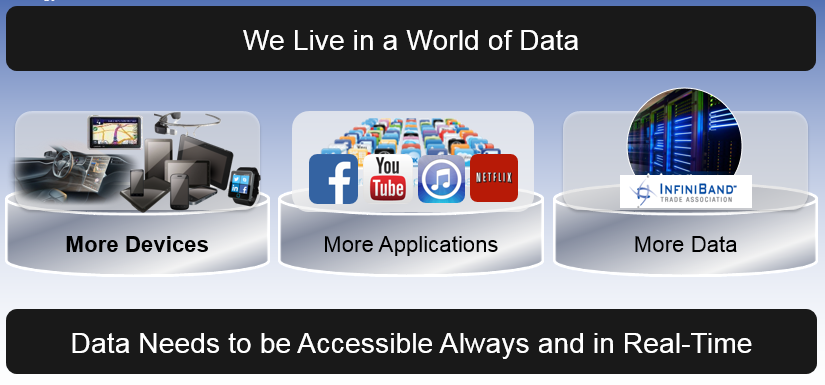On April 14-16, Ethernet designers and experts from around the globe gathered at the Ethernet Technology Summit 2015 to discuss developments happening within the industry as it pertained to the popular networking standard. IBTA’s Diego Crupnicoff, co-chair of the Technical Working Group, shared his expertise with attendees via a presentation on “Accelerating Data Movement with RDMA over Converged Ethernet (RoCE).” The session focused on the ever-growing complexity, bandwidth requirements and services of data centers and how RoCE can address the challenges that emerge from new enterprise data center initiatives.
Here is a brief synopsis of the points that Diego covered in his well-attended presentation:
People are living in an ever-increasing digital world. In the last decade, there’s been an explosion of connected devices that are running many applications and creating massive amounts of data in the process that must be accessible anytime, anywhere.

Over time, the data center has emerged as the workhorse of the networking industry, with the increased pace of the ‘information generation’ generating many new data center initiatives, such as the cloud, virtualization and hyper-converged infrastructure. Expectations for enhanced accessibility to larger sets of data are straining enterprise data networks, bringing about a variety of new challenges to the industry, including the following needs:
• Scale and Flexibility
• Overlays & Shared Storage
• Reduce Latency
• Rapid Server-to-Server I/O
• Big Storage, Large Clusters
• New Scale-out Storage Traffic
The Transmission Control Protocol (TCP) has had difficulty keeping up with some traffic stemming from newer, more demanding applications. In these cases, packet processing over TCP saturates CPU resources, resulting in networks with low bandwidth, high latency and limited scalability. The industry was in need of a capability that would bypass the CPU altogether to enable faster, more efficient movement of data between servers.
The advent of Remote Direct Memory Access (RDMA) did just that, utilizing hardware offloads to move data faster with less CPU overhead. By offloading the I/O from the CPU, users of RDMA experience lower latency while freeing up the CPU to focus its resources on applications that process data as opposed to moving it.
Recently, RDMA expanded into the enterprise market and is now being widely adopted over Ethernet networks with RDMA over Converged Ethernet or RoCE. The RoCE standard acts as an efficient, lightweight transport that’s layered directly over Ethernet, bypassing the TCP/IP stack. It offers the lowest latency in the Ethernet industry, which enables faster application completion, better server utilization and higher scalability. Given these advantages, RoCE became the most widely deployed Ethernet RDMA standard, resulting in millions of RoCE-capable ports on the market today.
For additional details on the benefits of RDMA for Ethernet networks, including RoCE network considerations and use cases, view the presentation in its entirety here.

